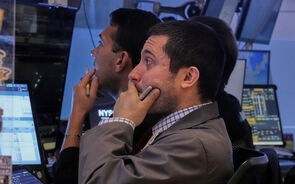Artigo sobre o que dizem e o que fazem os "américas&quo
2 mensagens
|Página 1 de 1
É bem sabido que o "Consumer Confidence" é um indicador que não presta, por não prever grande coisa. Nem sequer é lagging. Simplesmente, é um indicador mau, que correlaciona com noticias, mercados de capitais e outras irrelevâncias.
Porém, foi promovido a uma coisa importante, sabe-se lá porquê.
Porém, foi promovido a uma coisa importante, sabe-se lá porquê.
- Mensagens: 3255
- Registado: 6/11/2002 19:27
Artigo sobre o que dizem e o que fazem os "américas&quo
Consumers Get Spring in Step, Not Wallets
Tuesday April 29, 4:42 pm ET By Victoria Thieberger
NEW YORK (Reuters) - American consumers were optimistic in April as the war in Iraq came to a swift conclusion, but that did not translate into a shopping spree, reports showed on Tuesday, suggesting the economy has yet to experience a post-war bounce.
Other data reflected an unexpected surge in employment costs, especially for health insurance and pension benefits, indicating companies are still being squeezed on costs even as they find it impossible to raise prices.
The Conference Board's index of consumer confidence catapulted to 81.0 in April from 61.4 in March, far above expectations of a reading near 70. It was the biggest one-month gain since after the end of the first Gulf War.
Other surveys have also shown a jump in sentiment since the fighting in Iraq ended, though not as large.
But economists caution that better confidence figures may not last while the labor market remains stagnant. The payrolls report on Friday is expected to show another slide in jobs in April, taking total recent losses to more than half a million.
"(We're seeing) a snap back from the depressed confidence levels prewar, but are you getting enough of a snap back that will translate into spending? That is still an unknown issue," said Steve Ricchiuto, chief U.S. economist at ABN AMRO Inc.
Consumer spending accounts for around two-thirds of the economy and is critical to the recovery. Households need to keep spending for long enough to convince wary businesses that it is time to start investing again.
U.S. Treasuries prices fell and stocks gained after the confidence report, although both markets retraced some ground later in the day. The Dow Jones industrial average ended day up 31.38 points, or 0.37 percent, at 8,502.99. The 10-year Treasury note finished off 7/32 in price, nudging its yield up to 3.93 percent from 3.90 percent late on Monday.
WATCH WHAT THEY DO
The confidence survey showed encouraging gains in its components for current and future conditions as the war drew to a close and oil prices fell, as well as a welcome decline in a measure of "jobs hard to get." But the main index remains below its historical average and the levels of last summer.
Economists often play down the significance of confidence measures, which tend to be a better guide to current spending than future spending plans.
Indeed, Federal Reserve Chairman Alan Greenspan has often said he prefers to watch what consumers do, rather than what they say.
The latest weekly store sales figures released on Tuesday would offer the Fed chief little comfort. They showed lackluster sales, slowed by cool spring weather.
Retailers had been hoping a late Easter this year would spur demand, but that did not happen. Bank of Tokyo-Mitsubishi and UBS Warburg (News - Websites) said sales fell 1.6 percent in the latest week, prompting them to lower a closely watched forecast for sales to a gain in April of 2 percent to 3 percent.
Another report, from Instinet, said sales rose 0.9 percent in the latest week, but the pace slowed sharply from earlier in the month.
"We think the dire outlook for jobs is an underlying factor restraining the consumer from more robust spending," said Martin Bukoll, a retail analyst with Northern Trust Corp.
Wal-Mart, the country's largest retailer, reported on Monday a chilly Easter brought little improvement to sales.
Some economists see the rise in confidence as a hopeful sign that could presage a long-awaited second-half recovery.
"We're in the middle of a mood swing in the country. I tend to think that shift in sentiment is going to be leading a lot of economic news," said JP Morgan economist Jim Glassman.
IN WAITING MODE
The massive job losses of recent months and patchy economic data would normally be enough to spur the Federal Reserve into another interest rate cut to lift the economy. But financial markets have all but given up hope of a cut at the Fed's next policy meeting on May 6.
The central bank has been counting on an improvement in the wake of the war, and financial markets will closely watch for an update on that view when Greenspan gives testimony to Congress on Wednesday. He will make his first comments on the economy since February.
Economists expect the Fed chief to be cautiously optimistic, pointing to positives like the recent fall in oil prices and improving corporate profits.
Other officials at the Fed have been more guarded about the outlook, citing worries about capacity overhangs in the nation's factories and the risk of consumers slowing down.
Surging employment costs could put fresh pressure on corporate margins. The Labor Department said its Employment Cost Index jumped 1.3 percent in the March quarter, the biggest jump in nearly 13 years.
Economists attribute some of the increase to seasonal factors and say it should not weigh on Fed thinking. Indeed, a 1.0 percent rise in wages will help support consumer spending.
"The big increase in both benefit costs and wages is a positive for the consumer, but a decided negative for the corporations," said Wachovia economist Matthew Ellis.
Tuesday April 29, 4:42 pm ET By Victoria Thieberger
NEW YORK (Reuters) - American consumers were optimistic in April as the war in Iraq came to a swift conclusion, but that did not translate into a shopping spree, reports showed on Tuesday, suggesting the economy has yet to experience a post-war bounce.
Other data reflected an unexpected surge in employment costs, especially for health insurance and pension benefits, indicating companies are still being squeezed on costs even as they find it impossible to raise prices.
The Conference Board's index of consumer confidence catapulted to 81.0 in April from 61.4 in March, far above expectations of a reading near 70. It was the biggest one-month gain since after the end of the first Gulf War.
Other surveys have also shown a jump in sentiment since the fighting in Iraq ended, though not as large.
But economists caution that better confidence figures may not last while the labor market remains stagnant. The payrolls report on Friday is expected to show another slide in jobs in April, taking total recent losses to more than half a million.
"(We're seeing) a snap back from the depressed confidence levels prewar, but are you getting enough of a snap back that will translate into spending? That is still an unknown issue," said Steve Ricchiuto, chief U.S. economist at ABN AMRO Inc.
Consumer spending accounts for around two-thirds of the economy and is critical to the recovery. Households need to keep spending for long enough to convince wary businesses that it is time to start investing again.
U.S. Treasuries prices fell and stocks gained after the confidence report, although both markets retraced some ground later in the day. The Dow Jones industrial average ended day up 31.38 points, or 0.37 percent, at 8,502.99. The 10-year Treasury note finished off 7/32 in price, nudging its yield up to 3.93 percent from 3.90 percent late on Monday.
WATCH WHAT THEY DO
The confidence survey showed encouraging gains in its components for current and future conditions as the war drew to a close and oil prices fell, as well as a welcome decline in a measure of "jobs hard to get." But the main index remains below its historical average and the levels of last summer.
Economists often play down the significance of confidence measures, which tend to be a better guide to current spending than future spending plans.
Indeed, Federal Reserve Chairman Alan Greenspan has often said he prefers to watch what consumers do, rather than what they say.
The latest weekly store sales figures released on Tuesday would offer the Fed chief little comfort. They showed lackluster sales, slowed by cool spring weather.
Retailers had been hoping a late Easter this year would spur demand, but that did not happen. Bank of Tokyo-Mitsubishi and UBS Warburg (News - Websites) said sales fell 1.6 percent in the latest week, prompting them to lower a closely watched forecast for sales to a gain in April of 2 percent to 3 percent.
Another report, from Instinet, said sales rose 0.9 percent in the latest week, but the pace slowed sharply from earlier in the month.
"We think the dire outlook for jobs is an underlying factor restraining the consumer from more robust spending," said Martin Bukoll, a retail analyst with Northern Trust Corp.
Wal-Mart, the country's largest retailer, reported on Monday a chilly Easter brought little improvement to sales.
Some economists see the rise in confidence as a hopeful sign that could presage a long-awaited second-half recovery.
"We're in the middle of a mood swing in the country. I tend to think that shift in sentiment is going to be leading a lot of economic news," said JP Morgan economist Jim Glassman.
IN WAITING MODE
The massive job losses of recent months and patchy economic data would normally be enough to spur the Federal Reserve into another interest rate cut to lift the economy. But financial markets have all but given up hope of a cut at the Fed's next policy meeting on May 6.
The central bank has been counting on an improvement in the wake of the war, and financial markets will closely watch for an update on that view when Greenspan gives testimony to Congress on Wednesday. He will make his first comments on the economy since February.
Economists expect the Fed chief to be cautiously optimistic, pointing to positives like the recent fall in oil prices and improving corporate profits.
Other officials at the Fed have been more guarded about the outlook, citing worries about capacity overhangs in the nation's factories and the risk of consumers slowing down.
Surging employment costs could put fresh pressure on corporate margins. The Labor Department said its Employment Cost Index jumped 1.3 percent in the March quarter, the biggest jump in nearly 13 years.
Economists attribute some of the increase to seasonal factors and say it should not weigh on Fed thinking. Indeed, a 1.0 percent rise in wages will help support consumer spending.
"The big increase in both benefit costs and wages is a positive for the consumer, but a decided negative for the corporations," said Wachovia economist Matthew Ellis.
-
Info
2 mensagens
|Página 1 de 1
Quem está ligado:
Utilizadores a ver este Fórum: Bar38, cisne3, GamesOver, JorgeLima73, Lisboa_Casino, rtinto, Sr.Marques e 77 visitantes


